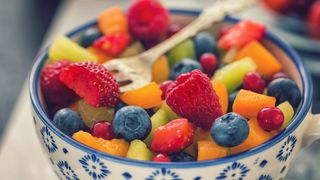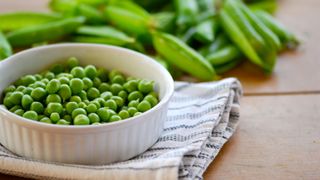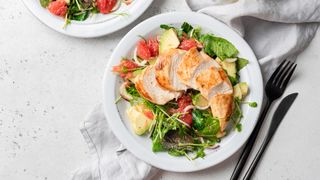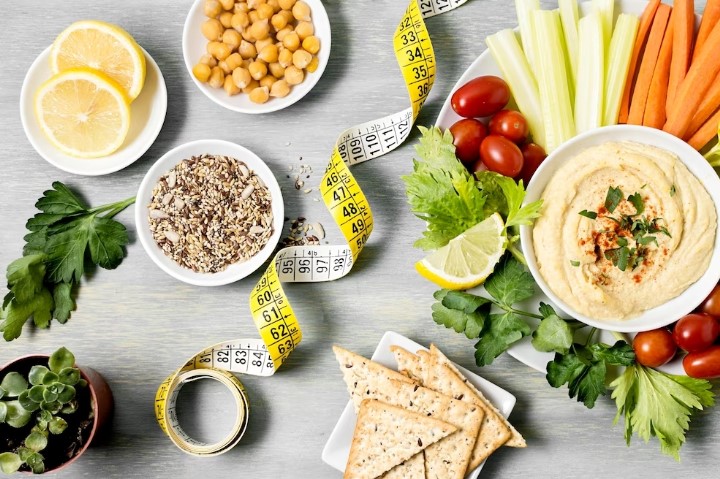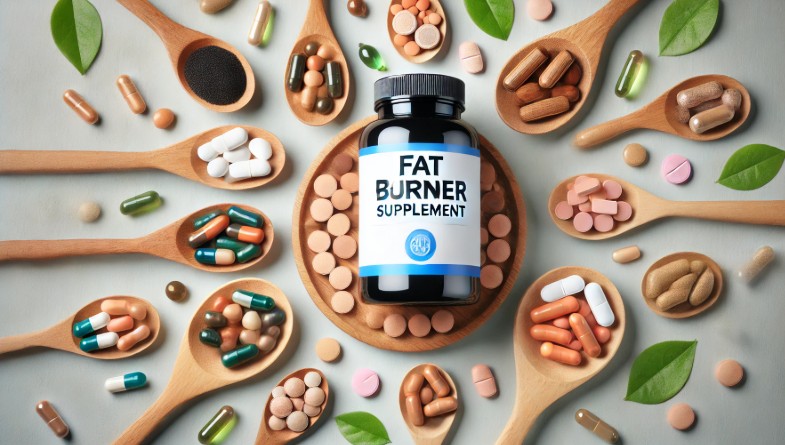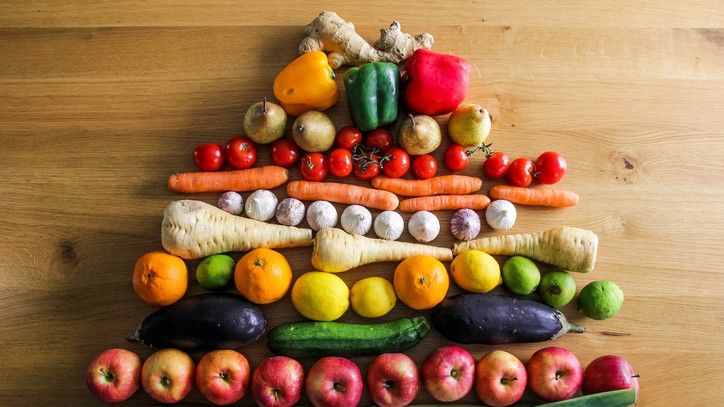
Eating a variety of foods from each of the five food groups can help you to enjoy a healthy, more-balanced diet. But what are the different food groups, and how much of each food group should we be eating every day?
Research from the Dietary Guidelines for Americans (opens in new tab) shows that 80{35112b74ca1a6bc4decb6697edde3f9edcc1b44915f2ccb9995df8df6b4364bc} of Americans’ diets are too low in fruit, vegetables, and dairy. While we are getting enough grain and protein foods, more than half of us aren’t getting them from varied sources, such as whole grains or plant-based proteins.
We’ve looked at the latest research to make it easier to identify the major food groups, and find out which foods don’t make the grade nutritionally. Plus, we’ve got expert tips and ideas for making healthy swaps that can last a lifetime.
What are the five food groups?
There are five main food groups set out by the Dietary Guidelines for Americans, under the MyPlate (opens in new tab) recommendations. Experts advise that everyone should be eating a variety of foods from each of these food groups, from around six months of age through to older adulthood, although recommended daily amounts vary by age, sex, and whether you’re pregnant or breastfeeding.
Fruits
How much? On average, we should be eating between 1.5 and 2.5 cups of fruit (opens in new tab) every day. Figures differ slightly for younger children, pregnant or breastfeeding women, and older men. MyPlate advises filling half your daily plate with fruits and vegetables and focusing on whole fruits in favor of juices or smoothies.
Fruits are naturally rich in vitamins and minerals, such as vitamin C, folate, potassium, and dietary fiber. They contain no cholesterol and are low in sodium, fat, and calories.
A cup of pure fruit juice or half a cup of dried fruit counts as one cup from the fruit food group, as do the following examples:
- 1 small apple or half a large apple
- 1 large banana
- 10 dates
- 5 fresh figs
- 22 seedless grapes
- 2-3 kiwis
- 10 kumquats
- 1 large orange
- 8 large strawberries
- a small wedge of watermelon
Vegetables
How much? On average, we should be eating between two and four cups of vegetables (opens in new tab) every day. Figures differ slightly for younger children, pregnant or breastfeeding women, and older people. MyPlate advises filling half your daily plate with fruits and vegetables and varying the range of veggies that you eat as much as possible.
Vegetables are essential sources of potassium, dietary fiber, folate, and vitamins, such as A and C. They’re also low in fat and calories.
A cup of raw or cooked veggies or vegetable juice, or 2 cups of raw leafy salad greens can count as 1 cup from the vegetable food group, as do the following examples:
- 2 cups of raw leafy greens, such as rocket, cilantro, romaine, chard or spinach
- 1 cup of cooked bok choy, broccoli, or cooked spinach
- 3 whole pimento
- 1 large bell pepper
- 1 large baked sweet potato or 1 medium baked or boiled white potato
- 1 large tomato
- 1 large ear of corn or a cup of kernels (fresh or frozen)
- 1 avocado
- 1 cup of green beans
- 1 cup of mushrooms
Grains
How much? On average, we should be eating between 3oz-5oz of grains every day. Figures differ slightly for younger children. MyPlate advises that at least half the grains on your plate are whole grains.
Grains are important sources of dietary fiber, complex carbohydrates, and many B vitamins, as well as being rich in iron.
One slice of bread, a cup of breakfast cereal, or half a cup of cooked rice or pasta can be considered as a 1oz equivalent on your daily plate, as do the following examples:
- 1 mini bagel (2in)
- 1 small biscuit
- half a cup of cooked bulgur wheat, couscous, or quinoa
- 1 packet of instant oatmeal
- 3 cups of popped popcorn
- 1 small chapati
- 1 pancake
- 1 corn tortilla
- 1 small muffin
- 5 wholewheat crackers
Protein
How much? On average, we should be eating between 5oz-7oz of protein every day. Figures differ for younger children.
MyPlate advises that you should vary your sources of protein to include foods such as seafood, lean or low-fat meat, poultry, eggs, nuts, beans, soy products, and lentils. The Dietary Guidelines for Americans also suggest replacing processed or high-fat meats with beans, peas, and lentils.
Protein is an important building block in the body, essential for the healthy development of bones, muscles, and skin. It’s especially important for growing children.
One ounce of most meats and fish, including deli meat, poultry, and game, are considered to be a 1oz equivalent on your daily plate, as are the following examples:
- 1 egg
- half an ounce of nuts
- half an ounce of seeds
- a tablespoon of nut butter or sesame paste
- half a cup of cooked beans, peas, or lentils
- 6 tablespoons of hummus
- 1oz of cooked tempeh
- 2oz of tofu
- a quarter cup of baked beans
- 1 falafel patty
Dairy
How much? On average, we should be consuming 3 cups of dairy every day. Figures differ for younger children and pregnant or breastfeeding women.
MyPlate advises that foods made with milk that are low in calcium, such as butter, sour cream, and cream cheese, are not considered to be part of the dairy food group. Vegetarian and vegan dairy alternatives, such as fortified soy milk and yogurt, are included because of their nutritional value.
Dairy foods are a great source of calcium, vitamins A and D, protein, potassium, zinc, and magnesium. Dairy foods and foods high in calcium are vital for growing children, as they support the healthy development of bones and teeth.
A cup of milk, yogurt, or soy milk counts as a cup of dairy on your daily plate, as do the following examples:
- 1 and half ounces of hard cheese, such as cheddar, Parmesan, or mozzarella
- a third of a cup of grated cheese
- half a cup of ricotta cheese
- 2 cups of cottage cheese
- 2oz of queso fresco
- 2 slices of queso blanco
- half a pint of calcium-fortified soy milk
Non-dairy alternatives that also contain calcium include:
- leafy greens, such as collard, spinach, and kale
- canned fish, such as sardines and salmon with bones
- calcium-fortified milk alternatives, such as rice or almond milk
Other foods
Foods that fit into the ‘other’ food group tend to be foods that have little to no nutritional value, and only provide empty calories. These include foods such as:
- soft drinks, alcoholic drinks, and other beverages
- sugary treats such as cookies, cakes, and candies
- fried or fatty foods and junk foods
- oils and solid fats, such as butter
While we all like to enjoy a sweet or savory treat from time to time, it’s important to keep these empty calorie foods to an occasional treat, and not make them part of your everyday diet. If you really can’t resist, try halving what you’d usually have, and see if that satisfies your craving.
Tips for eating a balanced diet
We asked Kimberly Snodgrass, a registered nutritionist, and spokesperson for the Academy of Nutrition and Dietetics (opens in new tab), for her top tips on getting a healthy, balanced diet.
1. Pack fruit and veg into every meal
“Food is medicine,” says Snodgrass. “So it’s important to pack as many fruit and veg in where you can.” That means making sure at least half your dinner plate is fruit or veg, adding fruit to your breakfast cereal or oatmeal, and swapping crudités in for cookies when you get a mid-afternoon slump. The more you’re able to pack in, the healthier you’ll be. You’ll also find you have more energy, and you’ll avoid the inevitable crash after the sugar high wears off.
2. Limit your sodium intake
Too much salt in your diet increases blood pressure, which can raise the risk of heart disease and stroke. Nine in 10 Americans (opens in new tab) already consume too much salt. Breads, pizza, junk food, and deli meats are all high in salt, so try to limit these foods in your diet.
If you’re cooking at home, Snodgrass recommends using a variety of herbs and spices to perk up your dishes, instead of relying on salt for extra flavor.
3. Avoid foods that are highly processed
Processed foods, such as sausages, bacon, deli meats and ready meals are likely to have extra salt, sugar, and fat added to them during the processing stage. Snodgrass advises limiting these as much as possible.
Opt for fresh sandwich meats, such as chicken or turkey instead of deli meat, or try whipping up a batch of sweet potato wedges instead of french fries.
4. Eat nutrient-rich foods
According to the American Heart Association (opens in new tab), nutrient-dense foods are rich in vitamins, minerals and other nutrients essential to good health. Just a few simple swaps can pack vitamins and minerals into your diet and help you avoid high-calorie, low-nutrient alternatives.
For example, opting for whole grain versions of pasta, breads, and rice will ensure you’re getting more protein and fiber for a start. Instead of adding extra cheese or meat to your pizza, think of a sliced vegetable topping as an alternative. Little changes can make a big impact, according to Snodgrass.
5. Have appropriate portion sizes
It’s easy to measure out a larger portion size than you really need, especially when you’re hungry. Tips to reduce your portion size include using measuring spoons and cups, eating from a smaller plate, filling half your plate with vegetables to reduce meat and carb portions, and having a glass of water before a meal to fill you up.
6. Consume foods that support your immunity
Snodgrass advises prioritizing foods that are good sources of vitamins and minerals to help boost your immune system, and keep you fighting fit. These include foods that are rich in vitamins A, C and D, as well as vitamins B6 and B12. Copper, folate, iron, selenium, and zinc are also well-known immunity boosters.
Here’s the good news: having foods from each of the five food groups helps to support your immune system. If you aim to eat a variety of fruits and vegetables, nuts, seeds, whole grains, dairy products (or their fortified alternatives), and meat, fish or plant proteins, you’ll be boosting your ability to ward off infections and illnesses, as well as eating healthily.
This article is for informational purposes only and is not meant to offer medical advice.

